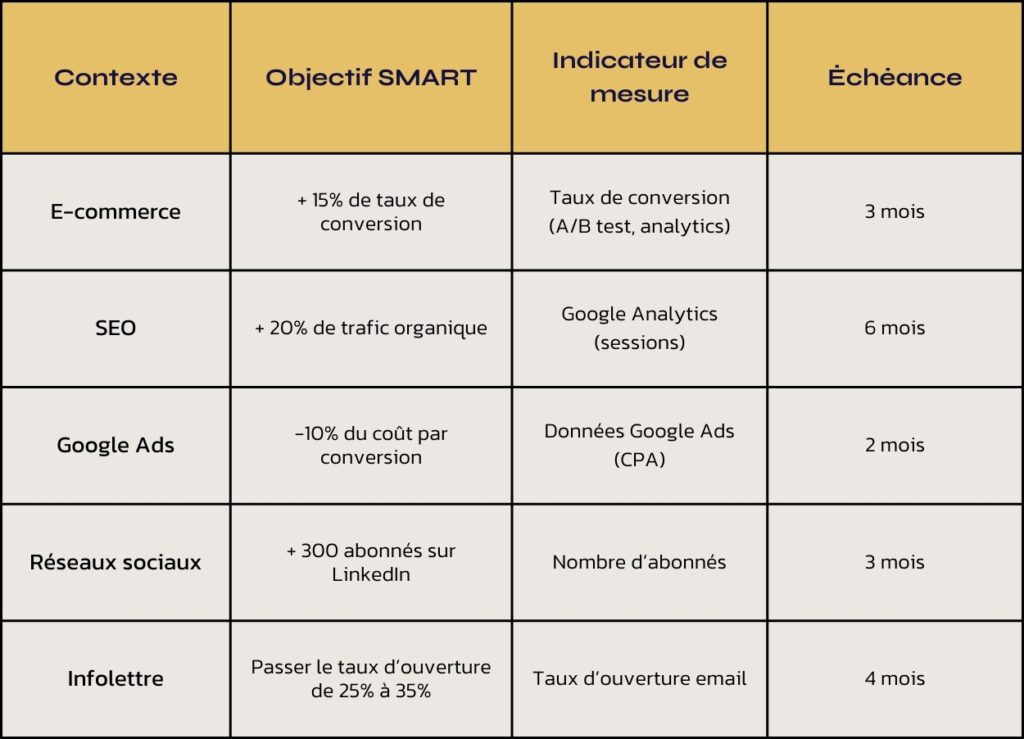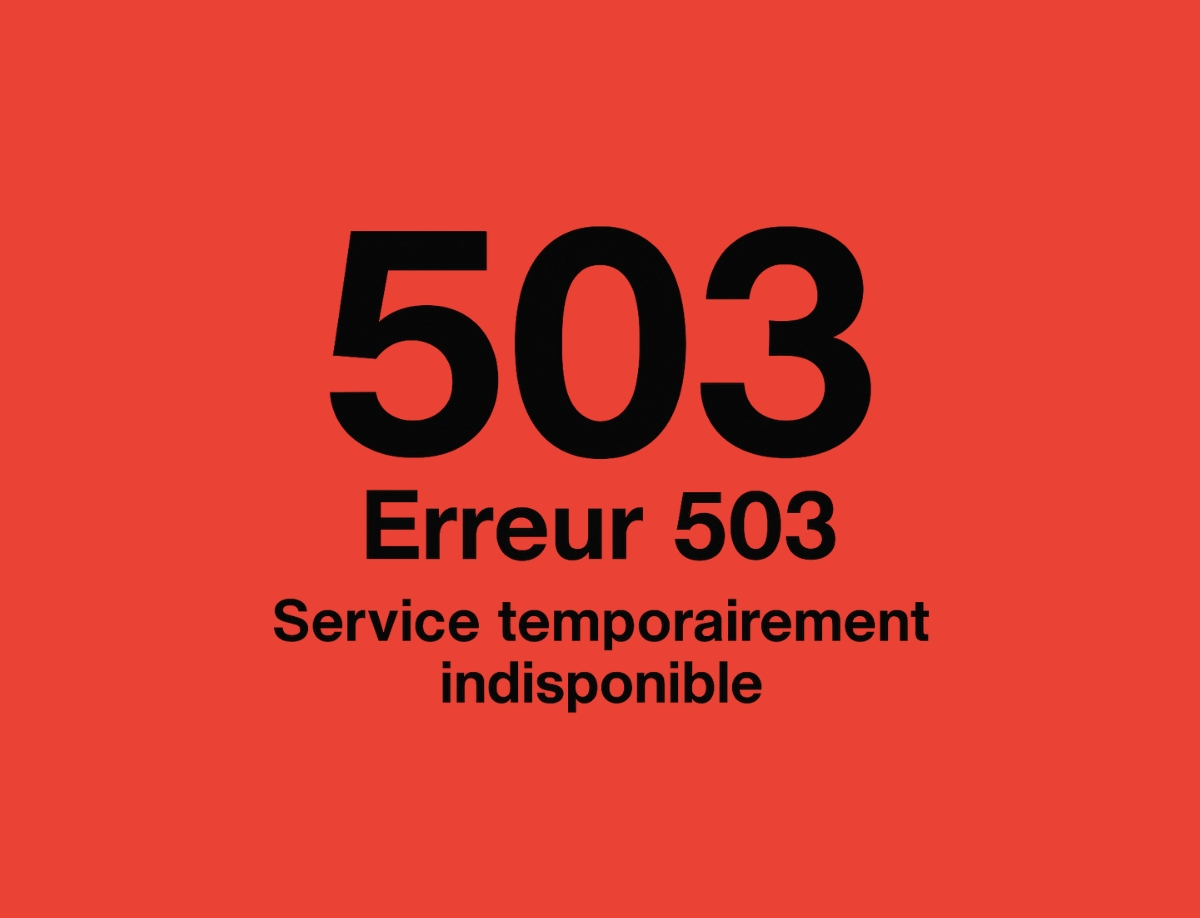Have you ever had a project in mind, but didn't know how to make it a reality? Defining a goal is sometimes simple, but moving from intention to results requires a method. That's where SMART objectives come in, an essential concept in project management and marketing.
At The Webix, we use this approach to help our clients structure their priorities. In fact, we find that having a clear goal improves motivation and facilitates decision-making. Yet, many people still don't know the exact definition of a SMART goal.
In this article, we will explore the SMART method, explain why it is so effective, and present concrete examples. We will also show you how you can implement it in five simple steps.
1. What is a SMART goal?
A SMART goal is a goal defined according to five specific criteria: Specific, Measurable, Achievable, Realistic (or Relevant), and Time-bound. This principle has existed since the 1980s. It helps clarify expectations and effectively track the progress of a project.
Unlike vague resolutions, a SMART goal forces you to detail what you want to achieve. In fact, it allows you to quickly assess whether you are making progress or need to adjust your strategy. This approach is popular in marketing, personal development, and team management.
In short, writing SMART goals encourages you to ask the right questions : Why is it important? How will progress be measured? By when? The answers to these questions make your project more concrete and motivating.
1.1 The SMART acronym: definition
- S for Specific
Your goal should be precise. It's not enough to say "I want to increase my sales." You should target a specific result or a particular product instead. - M for Measurable
You need to quantify your progress. Numbers, percentages, or clear indicators help track your advancement. - A for Achievable
The goal should not be too easy or impossible. Find a balance between ambition and feasibility. - R for Realistic or Relevant
The goal should make sense. It should also align with your resources, skills, and context. - T for Time-bound
Set a deadline or specific time frame. Without a deadline, the goal remains vague and may never materialize.
2. Why use the SMART method?
2.1 Why set smart goals?
SMART goals force you to be precise. In this way, instead of formulating a vague desire, you clearly define what you want and how you will achieve it. This clarity prevents unnecessary efforts and keeps you focused on what matters.
Furthermore, setting SMART goals creates a positive dynamic. You quickly see your first results. This boosts motivation and encourages you to keep going despite challenges. Indeed, seeing concrete progress builds confidence in your abilities.
Finally, clearly defined goals make communication easier. Your colleagues, partners, or suppliers better understand your vision. Everyone knows what they need to do to reach the target. This transparency fosters cohesion and collaboration within a team.
2.2 The benefits of the smart lens
- Clarity and simplicity : You eliminate vague phrasing and gain efficiency.
- Measuring progress : Quantitative indicators allow you to quickly assess your advancements.
- Adaptation to reality : The SMART method considers your means, deadlines, and priorities.
- Increased motivation : Every step taken becomes a small victory. You feel a sense of accomplishment.
- Improved planning : You identify necessary resources. Tasks are better spread over time.
3. The 5 criteria for formulating a SMART goal
When you decide to apply the SMART method, you need to check each criterion. Let's go through these five letters in detail. By using these benchmarks, you will be ready to create clear and motivating goals.
3.1 S for Specific
A goal must be precise and detailed o be effective. Avoid vague phrases like "I want to perform better," as they lack clarity. Instead, clearly indicate the nature of your goal to better guide your actions. For example, you could write: "Gain 20% new subscribers to my newsletter."
This precision provides a clear direction and helps your team understand the expected outcome. Additionally, a specific goal greatly facilitates the planning of the necessary steps and improves task organization.
3.2 M for Measurable
A goal that is not measurable complicates progress evaluation and makes tracking more difficult. To stay effective, you need tangible and precise indicators. Measurement can be done in terms of units sold, growth percentages or time saved..
For example, if you aim to gain 500 new sign-ups within three months, you can quickly check if you are on track. Additionally, analysis tools will help you track these data in real time and adjust your strategy if necessary.
3.3 A for Achievable
The goal should be ambitious but also realistic. If it's too easy, you won't push yourself and will make little progress. On the other hand, if it's too high, you may lose motivation and resources, which could slow down your progress.
To stay on track, start by reviewing your past results and the resources at your disposal. Then, compare your goal to your ability to act, taking into account your resources and skills. This way, you'll find a healthy balance that will allow you to progress effectively towards your goal.
3.4 R for Realistic
The notion of realism primarily concerns alignment with your vision and resources. Indeed, your goal must address a real need. Moreover, it should be relevant to your business or your current situation.
If your goal doesn't align with your values, it will be hard to mobilize the energy needed. Therefore, a relevant goal naturally fits into your overall strategy and facilitates its implementation.
3.5 T for Time-bound
Each goal should be set within a defined period. It can be one month, a quarter, or even a year. By setting a deadline, you create a positive sense of urgency that fosters commitment.
Additionally, this deadline encourages you to act without continuously postponing the effort. It also allows you to break the goal down into intermediate steps, making it easier to manage on a daily basis.
4. The 5 steps to implement the SMART method
The SMART method is not just about formulating a goal; it also involves a five-step application process. Here's how to proceed to effectively structure your ambitions and give yourself the best chance of success.
4.1 Step 1: Clearly state your goals
The first step is to clearly define what you want to achieve. To do this, avoid vague statements like "increase sales"; instead, opt for a detailed formulation: "Increase my sales by 25% by the end of next quarter."
- Clarity and precision : The clearer your goal is, the easier it will be for you and your team to understand.
- Alignment with your values : Check that this goal aligns with your overall strategy. You’ll be more motivated to achieve it.
- Relevance : Ensure that the goal chosen has a real impact. A secondary goal is less likely to be achieved.
4.2 Step 2: Set a deadline
A goal without a deadline risks getting lost along the way. Therefore, set a realistic timeframe that will keep your mind alert.
- Create a sense of urgency : A deadline pushes you to act and prevents you from constantly postponing your actions.
- Plan your schedule : Break your period into milestones (weekly, monthly…). This will allow you to track your progress without getting sidetracked.
- Stay flexible : If an unforeseen event occurs, you can adjust your deadline. The goal is to maintain your motivation and initial momentum.
4.3 Step 3: Identify potential obstacles
Before you start, take the time to think about what might hinder your progress.
- Evaluate resources : Do you have the necessary budget, equipment, or skills? A lack of resources can quickly become a major obstacle.
- Identify external constraints : Market competition, regulatory changes… Anticipating these factors will help you adapt more quickly.
- Find solutions : For each obstacle, already consider a plan B (training, recruitment, new strategies). This way, you'll anticipate difficulties before they become insurmountable.
4.4 Step 4: Determine how to evaluate your success
Measuring progress is essential to know if you're getting closer to your target or if you need to change your approach.
- Choose key indicators : Depending on the goal, focus on numbers (e.g., revenue, number of subscribers, conversion rate) or qualitative data (e.g., customer satisfaction, feedback).
- Track your progress regularly : Ideally, set up weekly or monthly tracking. This will allow you to react quickly if there’s any drift.
- Compare results to your goals : Analyze any gaps: Are they due to a lack of resources or a bad strategy? Adjust your plan accordingly.
4.5 Step 5: Develop a plan and take action
Once your goal is defined, your deadline set, obstacles identified, and indicators chosen, it's time to build a detailed action plan.
- List key tasks : What concrete actions need to be done? Rank them by priority.
- Assign roles : Who does what? Assign responsibility for each task to avoid confusion.
- Allocate resources : Ensure that each person has the time and tools needed.
- Monitor and adjust Plans are not set in stone. If an action proves ineffective, modify it without delay.

By following these five steps, you provide your SMART goals with a solid foundation. Indeed, this allows you to stay focused on your priorities, anticipate difficulties, and measure your progress at each phase of the project.
5. Examples of smart targets in different contexts
Examples of SMART goals vary by sector. Here are several cases to inspire you and adapt the method to your reality.
5.1 E-commerce
SMART goal : Increase the conversion rate on your online store by 15% within three months.
- Specific : Target the conversion rate (number of purchases per visit).
- Measurable Track this rate via your e-commerce analysis tool.
- Achievable : Track this rate via your e-commerce analytics tool.
- Realistic : Base it on your sales history and available resources.
- Time-bound : Achieve this result within 90 days.
5.2 SEO (Organic Search)
SMART goal : Increase organic traffic to your product pages by 20% over the next six months.
- Specific : Target organic traffic, not paid traffic.
- Measurable : Use Google Analytics to measure visits.
- Achievable : Optimize content and site structure, get more backlinks.
- Realistic : Set a goal in line with your competition and keywords.
- Time-bound : Respect the six-month deadline.
5.3 Google Ads
SMART goal : Reduce cost per conversion (CPA) by 10% over the next two months.
- Specific : Target CPA, a key indicator to control campaign profitability.
- Measurable : Monitor Google Ads data.
- Achievable : Adjust bids, optimize ads and landing pages.
- Realistic : Check your resources and advertising budget.
- Time-bound : Set an eight-week timeframe to observe changes.
5.4 Social Media
SMART goal : Acquire 300 relevant new LinkedIn followers within three months.
- Specific : Define the targeted social network and nature of engagement.
- Measurable : Track the number of followers weekly.
- Achievable : Post quality content and interact with targeted groups.
- Realistic : Consider your current account visibility.
- Time-bound : Allow 90 days to achieve this goal.
5.5 Newsletter
SMART goal : Increase the open rate of your newsletter from 25% to 35% in four months.
- Specific : Target the open rate, a key indicator of subscriber interest.
- Measurable : Track statistics via your sending platform.
- Achievable : Improve the subject line and segment the mailing list.
- Realistic : Review open rates history to determine a credible goal.
- Time-bound : Respect a 120-day timeframe to observe changes.

Towards a concrete smart goal
A SMART goal is a powerful tool for any professional or entrepreneur who wants to go from theory to practice. In short, this method provides a clear structure: you know exactly what to aim for, how to measure progress, and when to act.
At The Webix, we see how this approach makes collaboration easier. That is, teams better understand priorities, which boosts collective motivation. Furthermore, the SMART method adapts to various fields: E-commerce, SEO, Google Ads, social media, or even your personal life projects.
Ultimately, the important thing is to stay true to your values and abilities. SMART goals are not set in stone. Of course, you can reassess them to account for unforeseen events or new opportunities. So, are you ready to define your next SMART goal? Now is the time to take the step!








